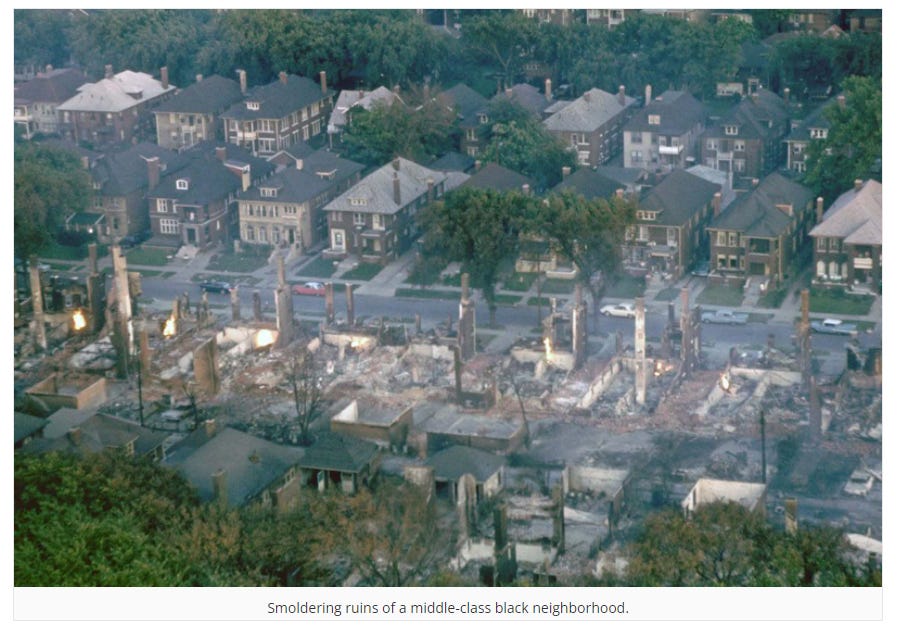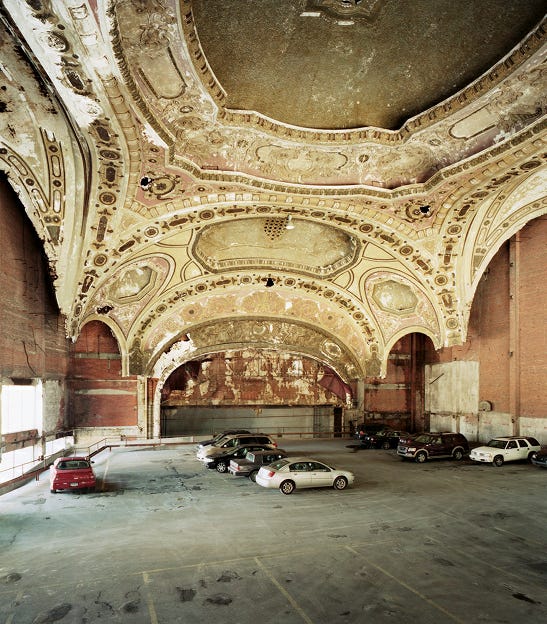The Motor City:
Detroit was nicknamed the “Motor City” because by 1924, the three biggest car companies that dominated the field—General Motors, Ford, and Chrysler—were all based in the Detroit area. And Henry Ford lived there.
The location was the perfect link to the factories via many supply chains. Being in the middle of the continent had a lot of pluses. With the Detroit River being fed by the Great Lake system, raw materials, parts, and finished products can travel to and from Detroit with ease, over water to and from the Atlantic coast.
By 1950, the auto industry had 296,000 manufacturing jobs in Detroit. That number dropped to just 27,000 in 2011.
By the 1970s and 1980s, the auto industry suffered setbacks that further impacted Detroit. The industry encountered the rise of OPEC and the resulting sharp increase in gasoline prices. It faced new and intense international competition, particularly from Italian, Japanese and German automobile manufacturers. Chrysler avoided bankruptcy in the late 1970s only with the aid of a federal bailout.
GM and Ford also struggled financially. The industry fought to regain its competitive footing but did so in a very substantial part by introducing cost-cutting techniques focused on automation and thus reduction of labor cost and the number of workers. It also relocated ever more of its manufacturing to lower-cost states in the U.S. and low-income countries. Detroit's residents thus had access to fewer and fewer well-paying, secure auto manufacturing jobs.
The leadership of Detroit failed to diversify the city's industry beyond automotive manufacturers and related industries. Because the city had flourished in the heyday of the auto industry, local politicians made periodic attempts to stimulate a revival of the auto industry in the city.
For example, in the 1980s the cities of Detroit and Hamtramck used the power of eminent domain to level part of what had been Poletown to make a parking lot for a new automobile factory. On that site, a new, low-rise suburban-type Cadillac plant was built, with substantial government subsidies. The new Detroit/Hamtramck Assembly employed 1,600 workers in 2013.
In the 1990s, the city-subsidized the building of a new Chrysler plant on the city's east side, Jefferson North Assembly, which employs 4,600 people.
In 2009 Chrysler filed a Chapter 11 bankruptcy case and survives in a partnership with Fiat of Italy, while GM filed for Chapter 11 bankruptcy on June 1, 2009, and survives as a much smaller company—smaller now than Japan's Toyota Motor Corporation. A little over two years after these major blows to the U.S. auto industry, the city itself went into Chapter 9 bankruptcy after years of mismanagement by local leaders. It is the largest municipal bankruptcy filing in U.S. history by debt, estimated at $19 billion.
Motown - Hitsville USA
In January 1959, former boxer and automobile worker, Berry Gordy started Motown Records. At the Detroit headquarters was a sign that read "Hitsville U.S.A." It was placed there soon after his company moved into the modest home at 2648 W. Grand Blvd.
Groups produced by Motown defied comprehension: Martha and the Vandellas, Smokey Robinson and the Miracles, The Temptations, The Four Tops, Diana Ross and the Supremes, Gladys Knight and the Pips, The Jackson 5, Stevie Wonder, Marvin Gaye. All became part of what would come to be known as the Motown Sound.
Throughout the Sixties, Motown produced a catalog of songs that cannot be rivaled. "You've Really Got a Hold On Me," "Heat Wave," "Dancing in the Street," "Tracks of My Tears," "Where Did Our Love Go," "My Guy," "My Girl," "Baby Love," "Reach Out, I'll Be There," "I Can't Help Myself," "Get Ready," "Stop! In the Name of Love," "The Way You Do the Things You Do," and so on. They were simple love songs that told simple stories, often in joyously happy or heartbreakingly sad ways. And all the while Motown was the pride of Detroit and the pride of black America (though Gordy tried, with his usual bluster, to make it the "Sound of Young America," a label he began to stamp on all of the company's vinyl). (…Source)
Because of staff changes, and decreasing record sales - in the summer of 1972, Berry Gordy moved the entire Motown operation from Detroit to Los Angeles. He called it MoWest. It shut down the following year and most of its catalog went quickly out of print.
Back in the 1960s, Detroit’s population was about 1.7 million people. By 2020 the population had shrunk to just 640,000.
Detroit Race Riots of 1967:
July 23, 1967 - The police raided an unlicensed bar and arrested 82 black residents. The community outrage this resulted in caused one of the largest riots in US history.
I was 11 years old, living in Windsor, Ontario at the time, just 2 miles south of Detroit, across the international border - the Detroit River. I wrote an article about the international Ambassador Bridge here.
I remember a friend and me with binoculars watching the smoke and hearing occasional gunfire from our rooftop. The police and national guard rolled through downtown Detroit with tanks trying to quell the violence.

Whole blocks had gone up in flames, (above picture) and the looting was so extensive that in some neighborhoods, alleys and sidewalks were lined with old sofas and armchairs that residents had cast out to make room for new furniture.
Sadly the riot resulted in the deaths of 43 people, including 33 African Americans and 10 whites. Many other people were injured, more than 7,000 people were arrested, and more than 1,000 buildings were burned in the uprising. The riot is considered one of the catalysts of the militant Black Power movement.
The Pontiac Silverdome - Home of the NFL Detroit Lions
In November 2009, the Pontiac Silverdome, an 80,000 seat arena — once home to the NFL’s Detroit Lions, and the NBA’s Detroit Pistons - was sold for $583,000, or about 1 percent of the $55.7 million it took to build in 1975. That is a bit more than half the cost of a single-family home in Kelowna, BC, Canada. It was demolished in 2017. The Pontiac Silverdome will always be remembered as the greatest stadium in Michigan's history.
Empty Real Estate Rots Away in Detroit:
There are a lot of empty buildings in Detroit. People left the area to find jobs elsewhere. Wouldn’t it be great for new manufacturers to come here, take advantage of some great tax breaks, and set up new manufacturing plants? To deter our reliance on China.
Sadly, nobody has that will or vision today at a scale that would make a difference. Maybe someday.
Here are a few specialty manufacturers in Detroit.

















This is an excellent account of the steady, relentless, destruction of a really great city.
Well, I'm not very happy with Detroit today, anyway. Their Lions beat my Cardinals yesterday. 🏈